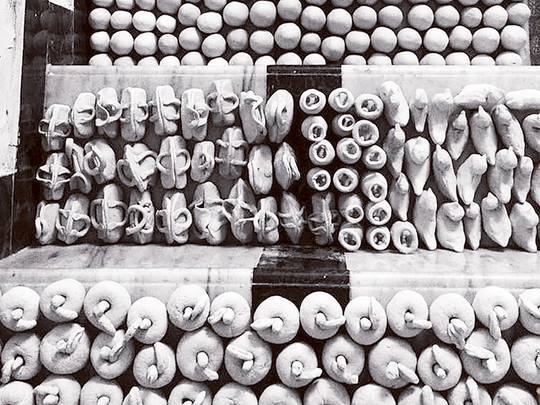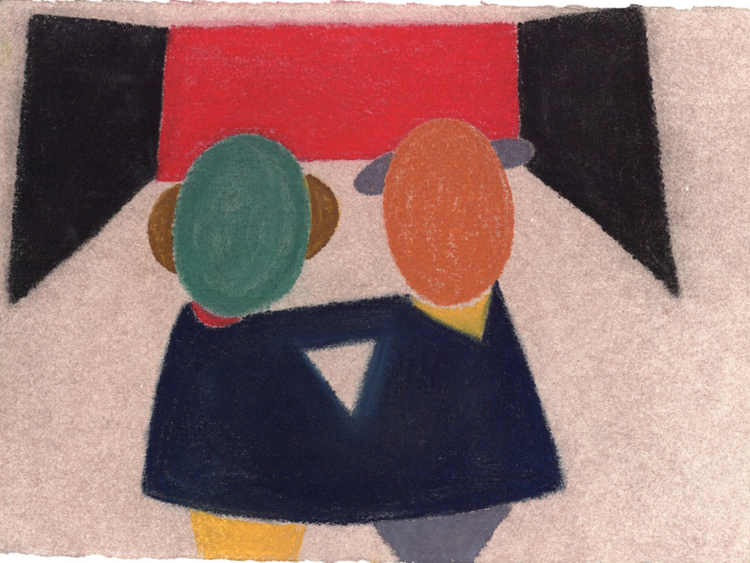
Judy Blum Reddy was born in New York, where her parents found refuge from the holocaust in Vienna. She later lived in Paris, where she met and married well-known Indian artist Krishna Reddy. Her work reflects the multiple cultures she has embraced. Poonam Jain belongs to the Marwari community from the western Indian state of Rajasthan, but she was born and raised in the southern Indian metropolis of Bengaluru, and now lives and works in Mumbai. Her work reflects her search for her roots and her concerns as a young urban Indian woman.
The two women artists come from different backgrounds and belong to different generations, but the themes they address and the materials they work with are quite similar. Both artists are interested in examining the systems and structures that shape our beliefs, perceptions and attitudes, to explore questions about personal and collective identity and the situation of women in a patriarchal society. Their joint show in Dubai — “Who Is She?” — is curated by Sumesh Sharma and sets up an interesting dialogue between their works.
Jain’s work is influenced by her sense of alienation from her culture; the philosophy of her Jain religion, which is based on mathematics and infinity, her memories of her father’s stationery shop and her experiences as an independent woman living in a big city.
In her ongoing series “Letter to Me” she has created a visual language to present her poems by representing each letter with a tiny clay sculpture of an object starting with that letter. Each line of a poem is represented by a set of objects arranged on a shelf. “As a Marwari who grew up outside Rajasthan I feel alienated from my culture. But connecting with my roots is difficult because the Marwari language has no script and hence no literature. Creating these installations is my way of developing a script,” she says.
The works she is presenting in this show include a poem titled “No Name” and installations that speak about shadows from her past, and about feeling unsafe in her own neighbourhood, through lines that get shorter progressively and letters precariously hanging upside down.
In another ongoing series, Jain repeatedly writes down numbers on paper in a futile effort to reach infinity. In recent large-scale drawings from this “Infinity” series, titled “Value Structures”, she has written down the numbers in words to create what look like architectural drawings. Similarly, in “Value Column” numbers (including the number of her bank account) are inscribed on white gypsum pillars reminiscent of the pillars in Jain temples. “The numbers represent the spiritual search for infinity as well as economic value. The architecture alludes to both physical and mental space, and the columns represent support systems for economic or religious structures,” Jain says.
The artist has placed a three-dimensional version of her architectural drawings, constructed with ear buds, in a shopping trolley in a work titled “Shopping”. “This movable artwork conveys a sense of floating architectural spaces, representing changing economic structures and systems, which fuel our needs. It reflects the freedom to make buying decisions that women now have, as well as the desires and addiction to shopping created by the choices available in huge malls,” Jain says.
In other works, Jain has used elements that reference her father’s stationery shop, such as the red ledgers he uses for keeping accounts, books, pictorial charts and erasers. The artist is also exhibiting nursery rhyme inspired sculptures made from fake denim and a printed fabric.
The element of meditative repetition and the traditional Indian accounting ledgers also appear in Blum Reddy’s work. In one ledger, she has written down the Ganga Namavali Strotra — the 108 names of the River Ganges that describes its beauty, power and nurturing nature. The ironical work comments on the fact that people chant the names or write them down in the hope of fulfilling their wishes, but although the Ganges is revered in a religion that venerates many female deities, the river is dying due to pollution, and the society’s attitude towards women is equally bad.
In other works, Blum Reddy has used the ledgers to copy out lists of castes, races, rivers, animals, plants, languages and other things from archives documented by the British to keep an account of all the resources they controlled in India. She also constructs the idea of contemporary India by listing major train routes and the names of the numerous governmental committees and sub-committees that make the tackling of issues such as poverty and welfare of women so inefficient and ineffective in India.
Like Jain’s letters to herself, Blum Reddy’s series of black-and-white serigraphs, “Small Songs”, speaks about the idea of home, self and fear, and just like Jain’s impossible infinity architectures, Blum Reddy’s drawings of maps depict imaginary Utopian places and unknown landscapes.
Jain’s fabric sculptures speak about the dark side of English nursery rhymes that are still taught in Indian schools, and the irony of a pattern from British textiles that contributed to the death of India’s artisan economy being copied by a handloom co-operative in independent India. Blum Reddy also comments on French colonial rule through drawings that speak about the way France continued to control its colonies in North Africa by leaving them in the hands of petty dictators.
Jyoti Kalsi is an arts-enthusiast based in Dubai.
“Who Is She?” will run at 1x1 Art Gallery in Alserkal Avenue, Al Quoz, until January 8.













